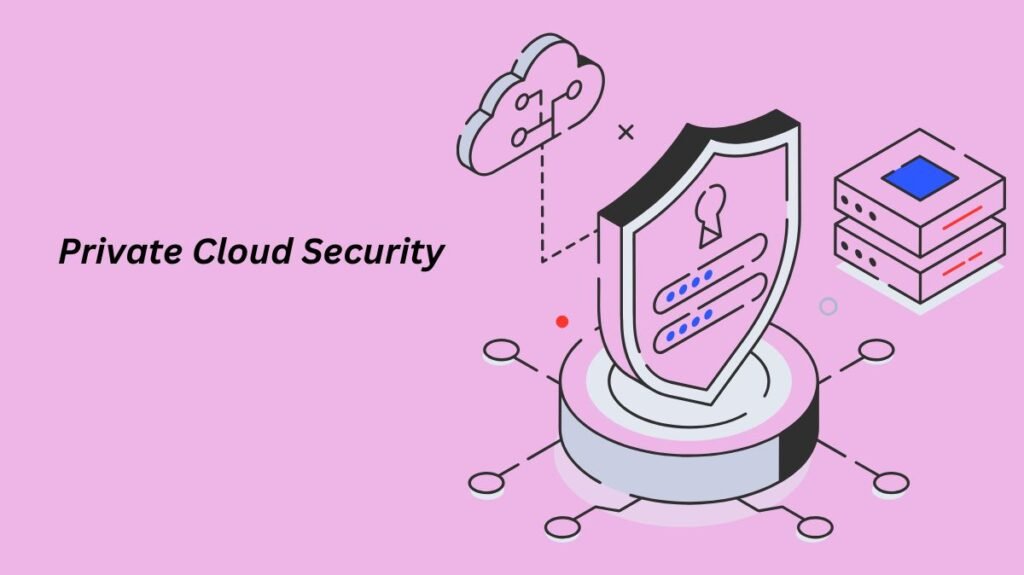Private Cloud Security

Tools and techniques for securing private cloud infrastructure are collectively referred to as private cloud security. Every resource in a private cloud is allocated to a single tenant. The private cloud security paradigm is different from multi-tenant public cloud settings since resources are allocated to particular businesses.
Components Of Private Cloud
Compute Resources
- Software that runs several virtual instances on a single physical server to optimize resource usage is known as virtualization technologies.
- Hypervisors: Give virtual machines (VMs) CPU, memory, and storage.
High performance, complete customization, and dedicated resources are all offered by bare metal. Perfect for applications with stringent compliance requirements, big databases, and high-performance computation. Using unified cloud management platforms, integration is handled alongside virtualized resources.
Containers provide isolated environments, portability, scalability, and lightweight virtualization. appropriate for cloud-native apps, CI/CD pipelines, and microservices. Integration with the current private cloud architecture is managed through the use of orchestration technologies such as Kubernetes.
Storage Systems
Network Attached Storage, or NAS:
It can operate efficiently as a NAS solution to file storage protocols like NFS and SMB. This makes it possible for several people and programs to collaborate and share files with ease. The platform extends NAS features to the cloud for increased scalability and flexibility through simple integration with cloud settings. The administration interface lowers administrative cost by making NAS resource configuration and monitoring easier.
Block Storage
It is perfect for high-performance applications like databases and virtual machines that need low-latency access to data since it blocks storage protocols like iSCSI and Fibre Channel. Because of its low latency and high throughput architecture, the platform can handle demanding block storage applications. Its scalable architecture makes it simple to expand to accommodate increasing demands for capacity and performance. Block data storage is a cost-effective solution because of data deduplication and compression characteristics.
Objects Storage
It is appropriate for archiving, backup solutions, and the storage of unstructured data with to object storage protocols like S3. Its cloud-native architecture makes it easy to integrate with both private and public cloud services, allowing for hybrid cloud deployments for object storage and simple data mobility. Whether using a hybrid cloud architecture or on-premises, the platform provides a range of settings to maximize the deployment of object storage solutions.
Cost-effective data protection is offered via backup and disaster recovery. An organization’s capacity to protect important data, maintain business continuity, and adhere to legal and regulatory obligations is improved by this integration.
Making connections
- Network virtualization is a technology that creates independent virtual networks by separating physical network resources.
- SDN: Software-based controllers manage network traffic and policies.
- To improve administration and security, VLANs and VXLANs create independent network segments.
Safety
- Firewalls are security systems that use rules to monitor and manage network traffic.
- Technology and frameworks for controlling resource access and user identities are known as identity and access management, or IAM.
Data encryption: Preserves information by rendering it unintelligible until it is decrypted.
Control and Automate
- Centrally manage cloud resources, rules, and services via CMPs.
- Orchestration tools automate cloud service management, coordination, and configuration.
- Monitoring and Logging: Systems that monitor cloud resource and service security, availability, and performance.
Private Cloud Pricing Models
The deployment size, bandwidth, and cloud platform can all affect a private cloud’s price:
The size and bandwidth of the deployment
For instance, a modest private cloud deployment with 100 virtual machines and 10 terabytes might cost $1,952, but a public cloud deployment of the same size would cost $7,731.
Cloud platform
Here are a few instances of private cloud pricing:
- Canonical’s Charmed Openstack: $1,500 per host for support, and $75,000 or $150,000 for design and delivery per engagement.
- Red Hat Openstack Platform: Support costs $6,300 for two CPUs, while design and delivery costs $75,000 or $150,000 per engagement.
- VMware vRealize: Support costs $1,986 per CPU or 25 virtual machines, while design and delivery costs $587,000 per cloud.
Compute, storage, and network needs
Depending on these requirements, cloud server prices might change. For instance, according to Oracle, a Kubernetes cluster with 100 vCPUs and 750 GB of RAM might cost $1,734 per month, whereas a virtual machine instance with 4 AMD vCPUs and 16 GB of RAM would cost $54 per month.
Businesses can utilise chargebacks to assign expenses to certain divisions or business units in order to control private cloud expenses.
Considerations for Private Cloud Use
- Cloud infrastructure requires specialist equipment and staff, making private clouds expensive to construct and operate.
Private cloud setup and maintenance involve virtualization, networking, and storage expertise. - Private cloud computing may underutilize resources since enterprises must plan for peak demands even if they rarely use their infrastructure.
- Because extending an organization’s infrastructure requires new hardware, private clouds are less scalable than public clouds.
- Regular maintenance and updates for private clouds may be expensive and time-consuming.
- As known, the private cloud is only available within the firm, limiting operational areas.
- Administration and management of cloud services require specialized professionals.

